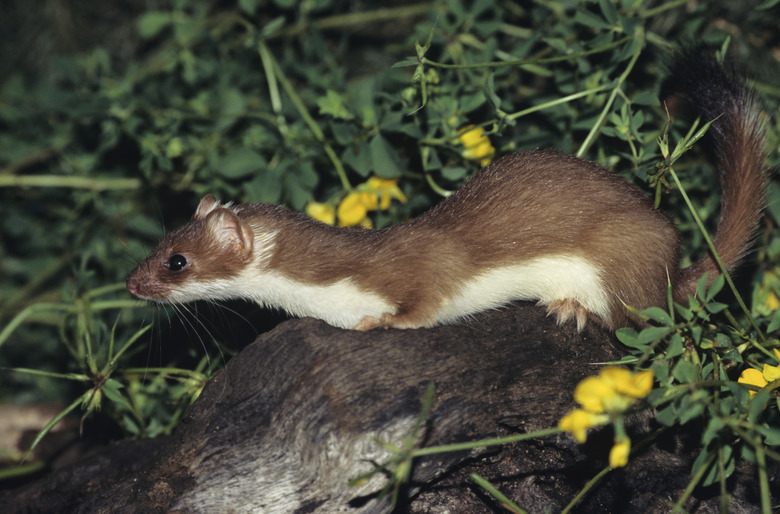The Signs Of Weasels
The three types of weasels that occur in North America all leave similar signs behind when they are present in their habitat. The ranges of the least weasel (Mustela nuvalis), the short-tailed weasel or ermine (Mustela erminea) and the long-tailed weasel (Mustela frenata) overlap in several regions of the continent. Given that the long-tailed weasel, for example, has the widest distribution of any carnivore found in North America, chances are you have seen weasel sign, whether you realized it or not.
Weasel Tracks
Weasel Tracks
Your best chance of spotting and identifying weasel tracks is in mud or soft sand near water, or after a light snowfall. All weasels possess five toes on their front and hind feet, but typically only four toes show up in their tracks.
The tracks of the three weasel types are similar, with the only differences being in the track's size and the distance they are apart. The smaller least weasel has a shorter distance between strides; the larger long-tailed weasel can sometimes have 20 inches between strides when bounding along.
Generally speaking, the three true North American weasels leave smaller prints than other native members of the weasel family, which include mink, martens, fishers, and other heftier carnivores.
Weasels walk by placing the hind foot where the front foot was, leaving a set of side-by-side tracks as they go. The front foot of the weasel is wider than the back, while the back foot is longer. Weasels rarely travel in a straight line, as they zigzag back and forth in a frantic search for prey, investigating every crevice and cranny as they hunt.
Weasel Scat
Weasel Scat
The scat that weasels leave behind is similar between species, with the exception that the smaller types create smaller scat. The color is normally a dark shade of black or brown. The scat is thin, long, usually in segments and tapered at one end. In many instances, weasels scat contains small pieces of bone or the hair of its latest meal.
Search for this sign of weasels on logs, stumps or rocky outcroppings, where weasels like to defecate.
Signs in the Snow
Signs in the Snow
During times of deep snow when you are out in the woods, look for holes in the snow where the weasel has jumped and dived beneath it in an attempt to locate prey such as mice and voles. You may notice drag marks away from a hole if these efforts were fruitful, as well as the presence of blood. Weasels do not suck the blood of their victims – a popular belief before more information about them surfaced – but they do lick it up.
Weasels have a habit of storing away any extra prey they manage to kill. You may stumble upon a cache of dead rodents such as voles under a log.
Smells and Sounds
Smells and Sounds
Weasels possess anal glands capable of leaving an unpleasant and pungent smell behind. It often accompanies their tracks and resembles the smell of another member of the family – the skunk. However, the weasel smell is not nearly as strong.
Weasels make a variety of sounds, including screeches, squeals, purrs and twittering trills in rapid succession. Weasels will resort to hissing when they feel frightened or threatened with danger. In general, though, you're less likely to detect weasels based on their vocalizations than by tracks and droppings.
Where to Find Weasels
Where to Find Weasels
One weasel type or another inhabits nearly all of North America – aside from the harshest portions of the hot deserts of the United States and Mexico borderlands and the far north of the Canadian Arctic. In other words, from a geographic perspective you've got a good chance of stumbling across weasel sign in almost every corner of the continent.
Weasels also use a range of habitats, from dense forest and wetland fringes to prairie, grassland, and dry semi-desert steppe. You can even occasionally find their sign in large city parks, in farmland and other partly-developed rural countryside.
Cite This Article
MLA
Lindell, John. "The Signs Of Weasels" sciencing.com, https://www.sciencing.com/signs-weasels-8701443/. 30 September 2021.
APA
Lindell, John. (2021, September 30). The Signs Of Weasels. sciencing.com. Retrieved from https://www.sciencing.com/signs-weasels-8701443/
Chicago
Lindell, John. The Signs Of Weasels last modified March 24, 2022. https://www.sciencing.com/signs-weasels-8701443/
